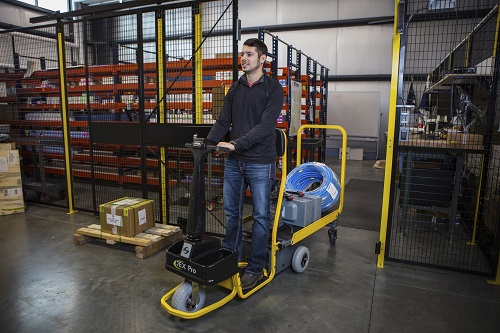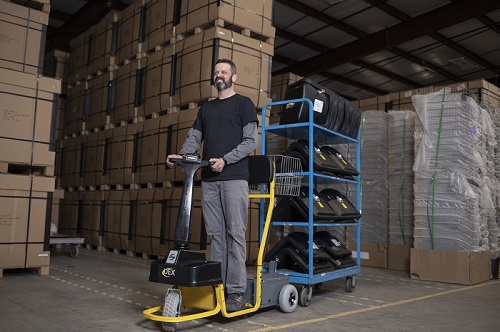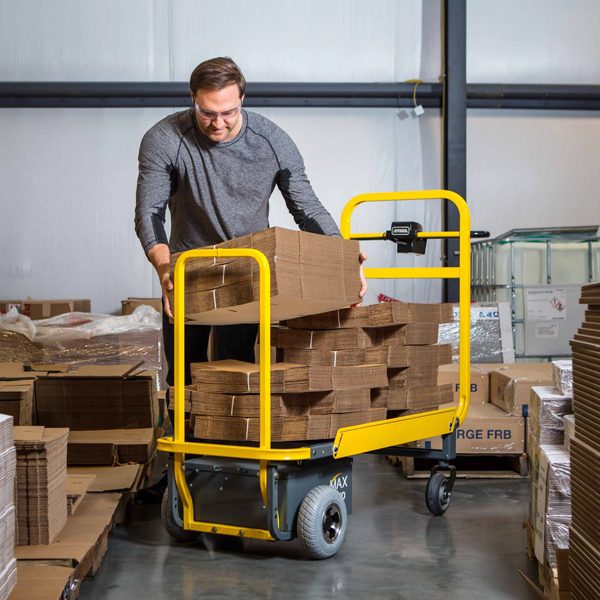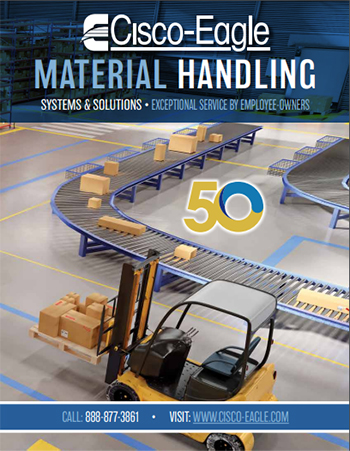Motorized Carts For Ergonomic Material Movement
Bridge the gap between manual carts, tuggers & forklifts

Forklifts are the usual method to move heavy materials, but there are plenty of times—and many good reasons—you might not want to use one. You can use pallet jacks, stackers, tuggers, pallet dollies, AGVs or even conveyors, but what about the instances where you don’t need forklift power, but your loads are too heavy or the travel time too far for pushcarts?
Enter the powered cart. This option resides in that “sweet spot” for material movement. But what exactly can a powered cart offer you, and what are your options?
Empowering movement and versatility
Motorized vehicles (or powered carts) are not new or unique to the warehousing landscape. Unfortunately, what they are is often overlooked as a way to provide your workers with another avenue for safe, speedy movement of materials.
These are low-tech, high-speed ways to transport products and people through a facility.
Versatility is key
 The simplicity of powered carts lets you use them in situations where traditional methods like tuggers don’t function as well.
The simplicity of powered carts lets you use them in situations where traditional methods like tuggers don’t function as well.
Their ability to haul up to 3,000 pounds and maneuver through narrow aisles lets you haul items almost anywhere on the floor. For operations looking to reduce the dependence on forklifts—go forklift free—adding a cart or two to your arsenal is a step in that direction.
With their rugged design and sturdy steel frames, these vehicles can take the daily punishment that working in a warehouse or distribution center dish out. They’re strong and supportive to any type of driver and can take almost any load you want to fit in their baskets or trailers.
In the era of scarce labor, any method that reduces repetitive motion and stress is a game-changer
By adding powered carts to your vehicle fleet, you can save precious employee steps and energy around a facility. Just these simple step savings can add up to better ergonomics, and healthier workers in your operations! Also, by allowing the users to get to a destination more quickly, you increase efficiency and speed up deliveries of equipment and merchandise throughout the operation floor.
Powered carts run on batteries, averaging around 30 miles run on each charge. You save money on fuel and propane vs. forklifts or some tuggers. Also, with the simple design of most powered carts, you get a vehicle that has fewer operating parts for fewer repair headaches. Easy maintenance is critical in any operation, so this can matter a lot.
Distance vs. time vs. efficiency
Another factor is the simple distance in very large plants. You can reduce the time it takes for people to cross the plant while they’re hauling a box of parts or a stack of cartons. They’re less likely to tire when they can drive a cart rather than push it. This allows aging workers to continue their careers for longer, giving you more labor flexibility.
Read more: Improving warehouse ergonomics
All part of a forklift free option
 By using powered carts, any operation can introduce smaller, more agile options for employees to zoom around in. This not only gives you a diverse lineup of motorized vehicles, but also adds backup options in case a forklift goes down.
By using powered carts, any operation can introduce smaller, more agile options for employees to zoom around in. This not only gives you a diverse lineup of motorized vehicles, but also adds backup options in case a forklift goes down.
You can also use increase the safety on your facility floor by using powered carts to keep forklifts in their place, since you should always try to define exclusion zones for forklifts and pedestrians. What I mean is that you can keep the forklifts in the zones in which they’re most needed in. No more wary forklifts down narrow aisles or heavy pedestrian areas limit the number of accidents that could occur.
Read more: Ways to reduce forklifts in your facility
Download Our Catalog
At Cisco-Eagle, we pride ourselves on being a single source for your material handling needs with a long history of performance you can rely on. Because we also believe in empowering our customers with detailed information and options, we’re proud to offer the latest version of our company catalog.
Download the catalog today
Tags: labor, ergonomics, Safety & Ergonomics
Evan Fleishacker




